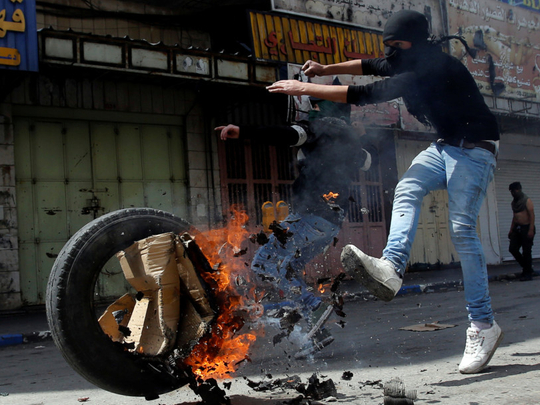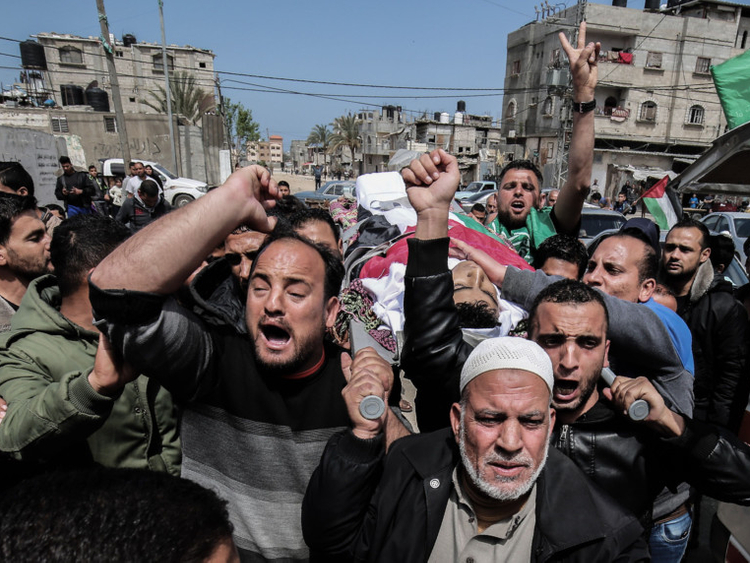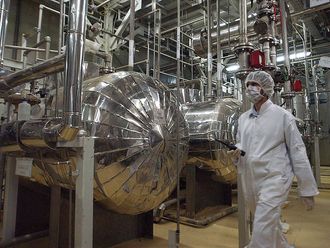
Gaza: Palestinians prepared for further protests near the Gaza border Saturday, a day after a major demonstration led to the Israeli regime massacring 16 people in the bloodiest day since the regime’s 2014 war on Gaza.
Protesters began returning to a tent city erected near the border with Israel to resume the demonstration planned to last six weeks in the blockaded enclave.
The six-week protest is in support of Palestinian refugees and the timetable holds significance for a range of reasons that have added to tensions.
It began on Land Day, when Palestinians commemorate the killing of six unarmed Arab protesters in Israel in 1976, and as Jewish Israelis readied to observe the Passover holiday, which started at sundown on Friday.
Protests will continue until the United States opens its new Jerusalem embassy around May 14, a move that has provoked deep anger among the Palestinians, who see the city’s annexed eastern sector as the capital of their future state.
May 14 will also mark 70 years since the creation of Israel, while Palestinians will commemorate what they call the Nakba, or “catastrophe,” the following day.
Nakba commemorates the more than 700,000 Palestinians who either fled or were expelled from their homes in the war surrounding Israel’s creation in 1948.
Thousands were attending funerals for those killed, with mourners holding Palestinian flags and some chanting “revenge”.
A general strike was being held in both the Gaza Strip and the occupied West Bank.
The Israeli regime defended its occupation soldiers’ actions on Friday.
But Palestinians accused Israel of using disproportionate force, while human rights groups questioned Israel’s use of live fire.
UN chief Antonio Guterres called for an “independent and transparent investigation”.
In addition to the 16 killed, more than 1,400 were wounded, 758 of them by live fire, with the remainder hurt by rubber-coated steel bullets and tear gas inhalation, according to the Gazan health ministry.
Palestinian President Mahmoud Abbas declared Saturday a day of national mourning and in a speech said he held the Israeli regime fully responsible for the deaths.
“The large number of martyrs and people wounded in peaceful popular demonstrations shows that the international community must intervene to provide protection to our Palestinian people,” he said.
Israel accused Hamas of being behind the protests and threatened wider military action if it continued.
US President Donald Trump has harshly criticised the Palestinians in the past, but the State Department said only that it was “deeply saddened” by the loss of life and urged steps to lower tensions.
Human Rights Watch criticised the regime’s actions.
“Israeli allegations of violence by some protesters do not change the fact that using lethal force is banned by international law except to meet an imminent threat to life,” the New York-based group said, calling the number of killed and wounded “shocking”.
Israel’s arch-foe Iran, a longstanding supporters of Hamas, condemned the “shameful” killing of protesters and mocked the fact that it happened as Israeli Jews prepared to mark Passover.
The regime has deployed troop reinforcements along the border, including more than 100 special forces snipers, saying it would prevent attempts to break through the fence.
Protests along the border are common, often culminating in young Palestinian men throwing stones at Israeli occupation soldiers who respond with tear gas along with steel-coated rubber and live bullets.
But the “March of Return” protest that began on Friday is larger scale and is intended to involve families with women and children camping in tent cities near the border for weeks.












